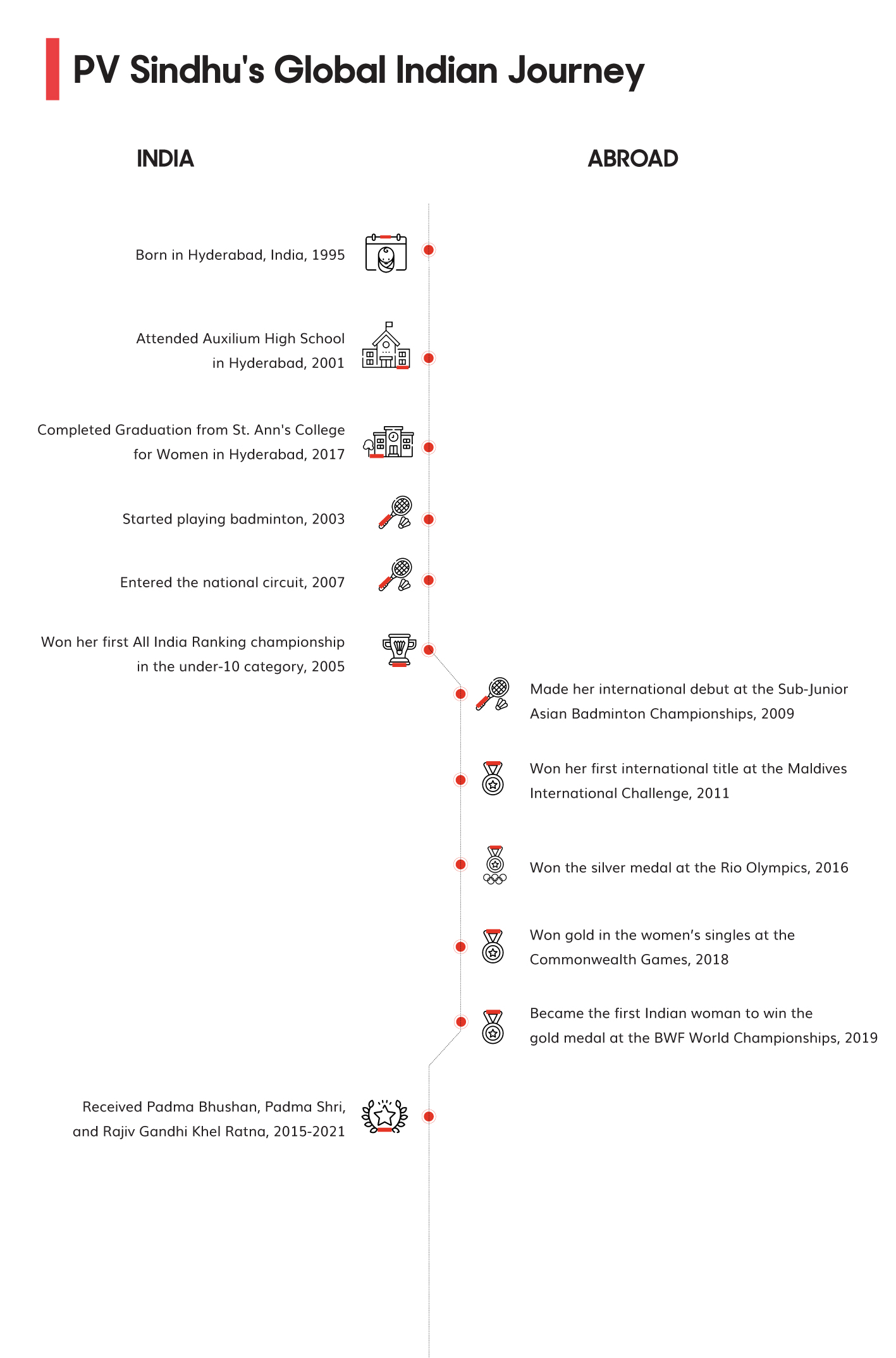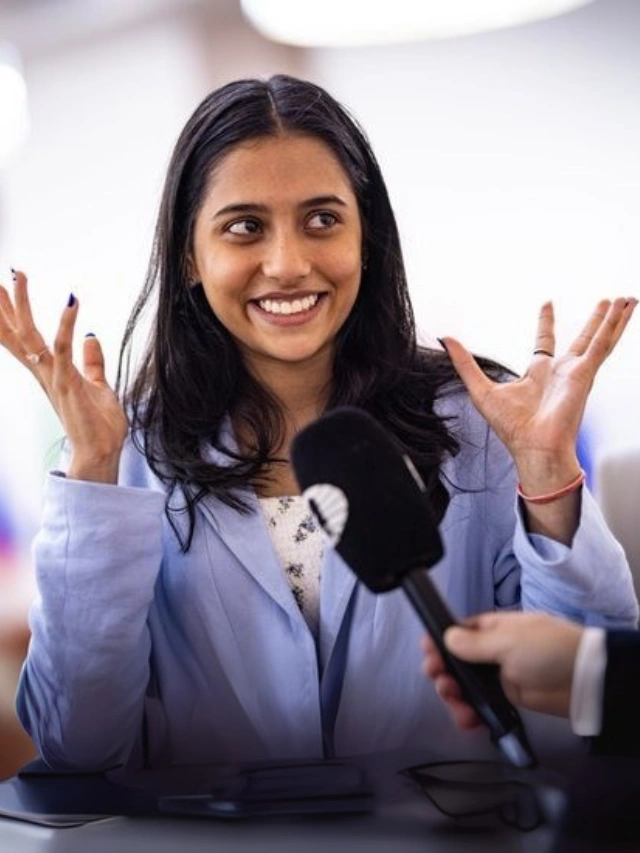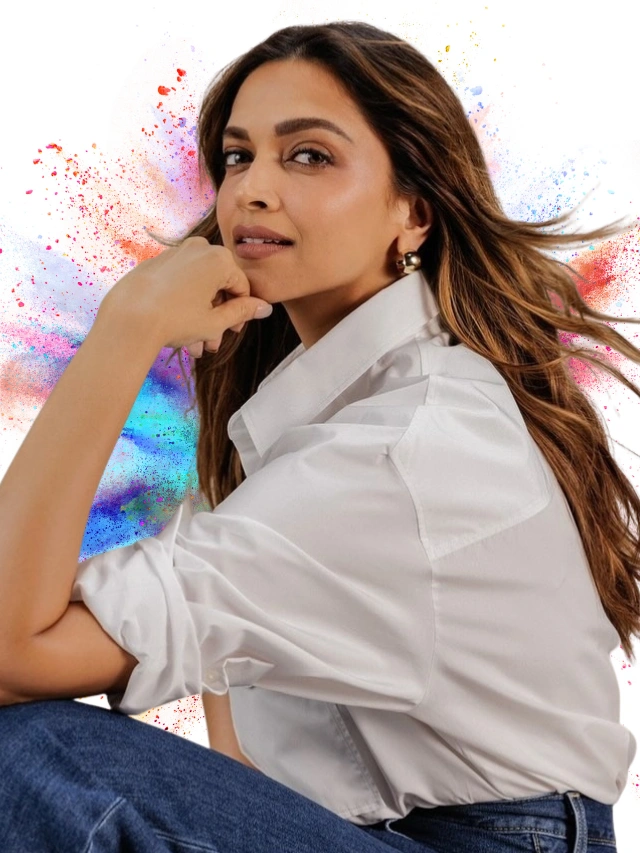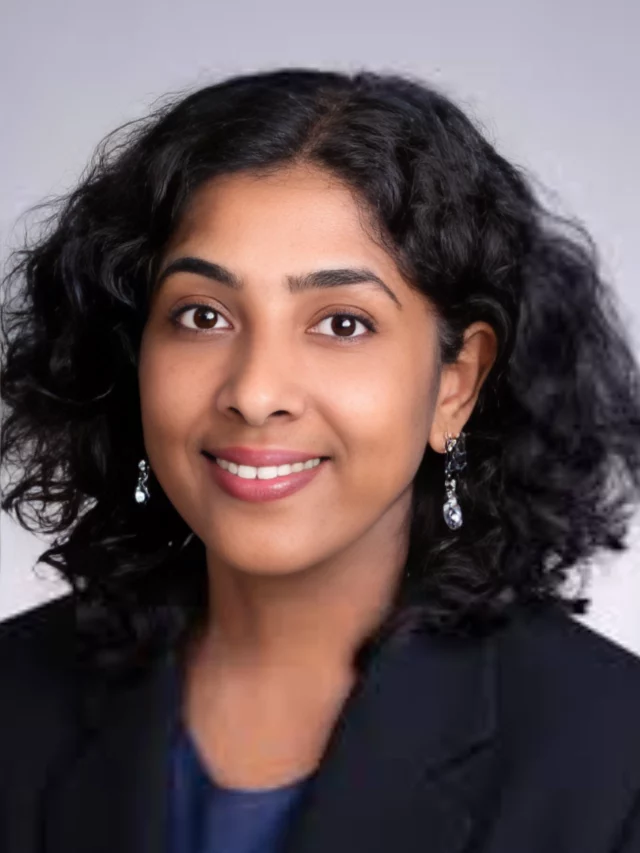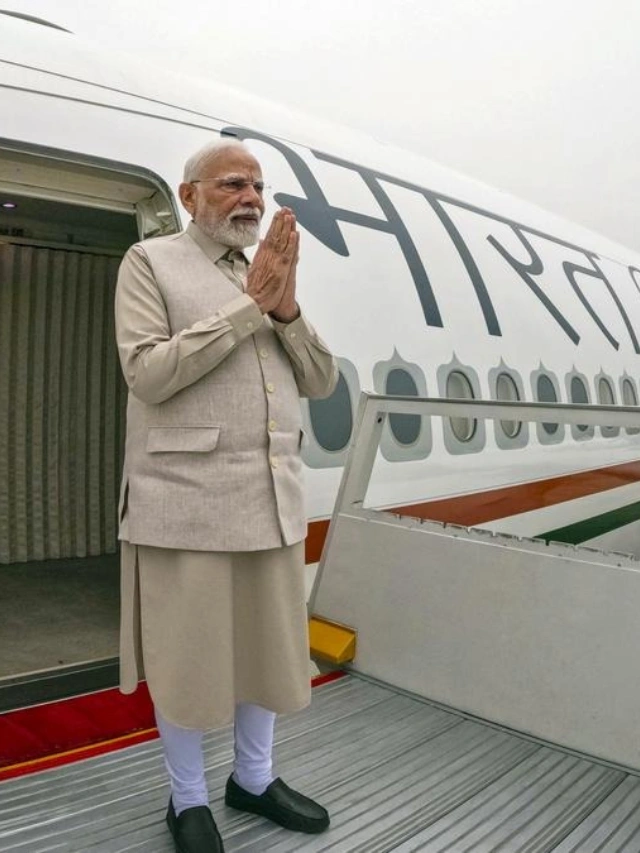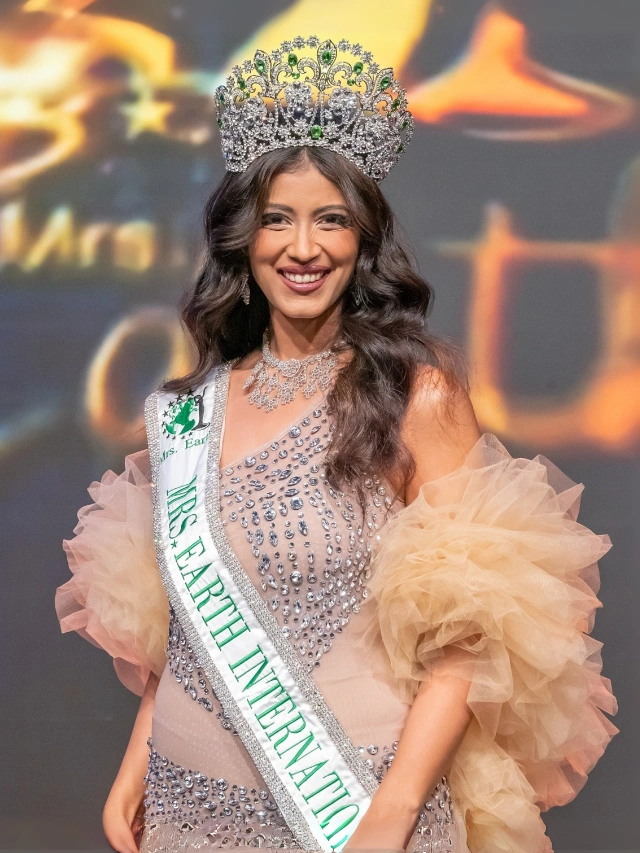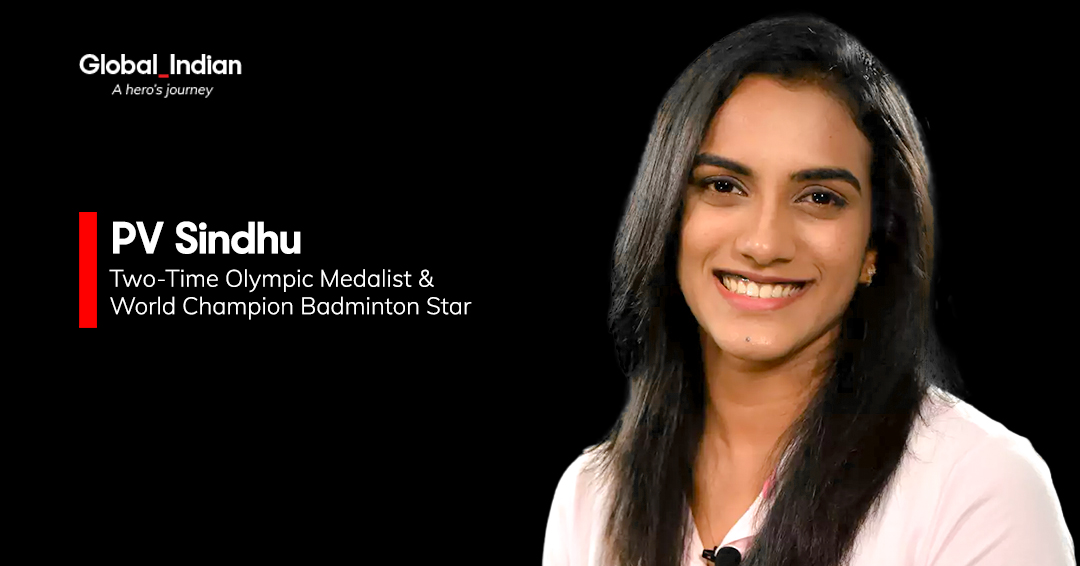
PV Sindhu
PV Sindhu has made history as the first Indian woman to win two Olympic medals. Her remarkable achievements make her one of India’s most successful athletes ever. She picked up her first badminton racket at age eight and went on to accomplish what most athletes only dream about. She became the first Indian to win the badminton world championship and secured both silver at Rio 2016 and bronze at Tokyo 2020 Olympics.
CEO’s | Actors | Politicians | Sports Stars
Pusarla Venkata Sindhu’s impressive record of 468 wins in women’s singles badminton and a career-high world ranking of No. 2 shows her dominance in international badminton. The 28-year-old champion has earned five BWF World Championship medals. Her excellence has brought her prestigious honors like the Padma Bhushan, Padma Shri, and Rajiv Gandhi Khel Ratna Award.
From her early training days under Pullela Gopichand to her rise as a global badminton icon, Sindhu’s story captures the pivotal moments that shaped her stellar career. Her dedication and skill have transformed her into one of badminton’s most formidable players.
“I have always believed that if you put in the work, the results will come. Success isn’t just about talent; it’s about perseverance and the willingness to push yourself beyond your limits.”
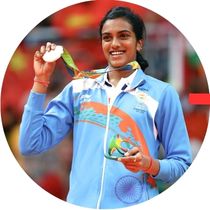
Early Life: The Making of a Badminton Prodigy
Born into a sporting family
PV Sindhu was born on July 5, 1995, in Hyderabad, Telangana, with athletics running deep in her family’s blood. Her father’s achievements include a bronze medal in volleyball at the 1986 Asian Games in Seoul. Her mother’s sporting legacy shines through her accomplishments as a national-level volleyball player. Young Sindhu spent time watching her parents practice with the South Central Railway volleyball team, but the sport didn’t catch her interest.
First encounter with badminton at age 8
Everything changed when six-year-old Sindhu watched Pullela Gopichand win the 2001 All England Open Badminton Championships. This amazing victory got her hooked on badminton instead of volleyball. She started her trip into the sport at age eight at the Indian Railway Institute of Signal Engineering and Telecommunications in Secunderabad. Coach Mehboob Ali taught her the basics. Later, she trained with former chief national badminton coach S.M. Arif at Hyderabad’s Lal Bahadur Shastri Stadium.
Training under Pullela Gopichand
Sindhu’s career took a huge leap forward when she joined the prestigious Pullela Gopichand Badminton Academy. The academy was 56 kilometers from her home, but that didn’t stop her steadfast dedication. She and her father made two round trips daily, traveling 30 kilometers each way to reach her training sessions.
Gopichand saw something special in Sindhu’s attitude and her never-say-die spirit. She tackled a tough training schedule while keeping up with her studies. Her determination showed in how she made it to coaching camps every day despite the long distance.
The mix of Gopichand’s world-class coaching, Sindhu’s natural talent, and her steadfast dedication became the foundation of one of India’s greatest sporting stories. She spent countless hours at the academy perfecting her technique and building the mental strength that would become her trademark in international competitions.
Career Journey: Junior Championships to International Debut
First national victories
PV Sindhu showed her exceptional talent early through remarkable wins in domestic tournaments. She won the singles title at the fifth Servo All India ranking championship in the Under-10 category. On top of that, it led to doubles titles at prestigious events like the Krishna Khaitan All India Tournament and the Sub-Junior Nationals in the Under-13 category.
Breaking into the international circuit at 14
Sindhu made her mark on the international stage in 2009 with a bronze medal at the Sub-Junior Asian Badminton Championships in Colombo. She made her senior international debut at the India Open that same year, though she competed mainly in junior events.
The next year became crucial as she reached the finals of the Iran Fajr International Challenge. Her ranking improved dramatically, jumping 87 spots from world No. 255 to No. 168 in February 2010. She managed to keep her position in the 160-190 range throughout 2010 while balancing both junior and senior circuit appearances.
Sindhu’s career took a decisive turn in 2011 as she focused more on senior-level competitions. Her breakthrough came with back-to-back wins at the Maldives International Challenge and Indonesia International Challenge. These wins pushed her into the top-100, reaching world No. 98 in August 2011. Strong performances, including a quarter-final finish at the Vietnam Grand Prix Open, helped her climb to world No. 75.
Asian Junior Championships gold medal (2012)
Sindhu’s junior career peaked in 2012 when she became India’s first-ever Asian Junior champion. She defeated Japan’s Nozomi Okuhara in a memorable final at the Gimcheon Indoor Stadium in South Korea. This victory stood out even more since she had won bronze in the same tournament before.
Her Asian Junior Championships success aligned with her growing success in senior competitions. She achieved a remarkable feat in September 2012 by defeating Olympic champion Li Xuerui of China at the China Masters and advanced to the semi-finals. This outstanding performance launched her into the top-20 world rankings. She reached the final of the Syed Modi International tournament and ended the year as world No. 19.
Breakthrough Moments: First World Championship Medal and Beyond
Historic bronze at 2013 BWF World Championships
PV Sindhu made history at the Tianhe Indoor Stadium when she became the first Indian woman to win a World Championships medal at just 18 years old. The tenth-seeded player beat defending champion Wang Yihan of China in straight sets 21-18, 23-21. She went on to outplay another higher-ranked Chinese player, Wang Shixian, with a score of 21-18, 21-17.
Consecutive bronze medals (2013-2014)
The 2013 World Championships success was just the beginning. Sindhu managed to keep her exceptional form into 2014 and secured another bronze medal at the World Championships. She became the first Indian to win back-to-back medals at this prestigious tournament. Her consistent performance against top-ranked opponents stood out, especially during high-pressure matches.
Recognition with the Arjuna Award
The Government of India recognized Sindhu’s groundbreaking achievements with the prestigious Arjuna Award. She received an Arjuna statue, Rs. five lakh, and a citation that acknowledged her outstanding contributions to Indian sports. This recognition created a unique family record – both Sindhu and her father became Arjuna awardees in different disciplines.
Sindhu’s medal collection grew steadily. She won a bronze at the Asian Championships by defeating Thailand’s Busanan Ongbamrungphan. She also played a key role in India’s bronze-medal finish in the Uber Cup and grabbed another bronze at the Asian Games in the women’s team event.
The years 2013 and 2014 helped establish Sindhu’s dominance in international badminton. She joined the elite company of Prakash Padukone, who won India’s first World Championships medal in 1983. Her achievements became even more special because she was just 18 years old, making her one of the youngest medalists in World Championships history.
Olympic Glory: The Silver That Changed Indian Badminton
Road to Rio 2016
PV Sindhu entered the Rio Olympics as the ninth seed at age 21. She had recovered from a serious stress fracture in 2015. Her performance proved her determination when she topped Group M by beating Hungary’s Laura Sarosi (21-8, 21-9) and Canada’s Michelle Li (19-21, 21-15, 21-17).
Defeating higher-ranked opponents
Sindhu showed remarkable skill by outplaying Chinese Taipei’s Tai Tzu-ying in straight games (21-13, 21-15). The quarter-finals brought a tough challenge against second-seeded Wang Yihan, but she secured a hard-fought win (22-20, 21-19). She dominated the semi-final match against Nozomi Okuhara in straight games (21-19, 21-10).
The final against Carolina Marin
The historic final against world number one Carolina Marin turned into an intense battle that lasted one hour and 23 minutes. Sindhu’s exceptional net play and retrieving skills helped her claim the first game 21-19. Marin bounced back strongly in the second game with an early 11-2 lead. The deciding game saw Sindhu fight back from 9-5 down to level at 10-10, but Marin ended up winning (19-21, 21-12, 21-15).
Impact of Olympic silver on her career
The silver medal achievement set multiple records. Sindhu became India’s youngest individual Olympic medallist and the first Indian woman to win an Olympic silver. The final got unprecedented attention with 17.2 TV viewers – the highest rating for any non-cricket game since BARC started in India.
This success pushed Sindhu’s career forward. She won the China Open right after by defeating China’s Sun Yu (21-11, 17-21, 21-11). Her outstanding performance earned her India’s highest sporting honor – the Rajiv Gandhi Khel Ratna Award.
Seven years later, Sindhu looked back at this defining moment: “Seven years ago, I embarked on a journey that would forever change my life… It was a silver, a shining symbol of my dedication, hard work, and the unwavering support of my coaches, teammates, and fans”. The medal reshaped Indian badminton’s scene and inspired many young athletes to excel in the sport.
Reaching the Summit: World Championship Gold and Tokyo Bronze
The Trip to World Championship Glory in 2019
PV Sindhu made history by winning India’s first badminton World Championship gold medal in Basel, Switzerland. She dominated Japan’s Nozomi Okuhara in a quick 38-minute final with straight sets (21-7, 21-7). Her powerful smashes left Okuhara struggling as she controlled the game from beginning to end.
Olympic Dreams During the Pandemic
The COVID-19 pandemic became a chance for Sindhu to refine her technical skills. She started training at the Suchitra Academy in Hyderabad and later moved to London’s National Training Center. There, she trained with British shuttlers Toby Penty and Rajiv Ouseph. Her South Korean coach Park Tae Sang helped her employ the extra preparation time to boost her performance.
Sindhu competed in five events when the circuit resumed before Tokyo 2020. She showed promising form by reaching the Swiss Open final and making it to the All England Open semi-finals in March. The draw placed the sixth-seeded player in Group J with Hong Kong’s Cheung Ngan Yi and Israel’s Kselina Polikarpova.
A Second Olympic Medal Makes History
Sindhu started her Tokyo 2020 campaign with dominant wins over Cheung Ngan Yi (21-9, 21-16) and Ksenia Polikarpova (21-7, 21-10). Her strong performance continued through the knockout stages with victories against Mia Blichfeldt (21-15, 21-13) and Asian champion Akane Yamaguchi (21-13, 22-20).
The significant bronze medal match against China’s He Bing Jiao saw Sindhu display exceptional skill. She won in straight games (21-13, 21-15). Her opponent struggled against her powerful crosscourt shots and strategic gameplay. This win made her the first Indian woman with two Olympic medals. She joined wrestler Sushil Kumar as the second Indian athlete to win multiple individual Olympic medals.
This victory carried extra weight as Sindhu’s total medal count at World Championships and Olympics reached seven. She matched China’s Zhang Ning’s record for most medals in women’s singles. Her impressive collection now has one gold, two silvers, and two bronzes at World Championships, plus Olympic silver and bronze medals.
Beyond the Court: PV Sindhu’s Life and Influence
Endorsements and business ventures
PV Sindhu ranks among India’s highest-paid athletes, with an impressive portfolio of brand endorsements. She represents prestigious brands like Asian Paints, Bank of Baroda, and Maybelline. She made headlines in 2019 by signing a landmark four-year deal worth Rs 50 crore with Chinese sports equipment giant Li Ning. Her endorsement fees now range between Rs 1.2 crore and Rs 2.25 crore per deal.
Marriage to Venkata Datta Sai
Sindhu married Venkata Datta Sai, Executive Director at Posidex Technologies, at Raffles Udaipur Resort in December 2024. The couple celebrated their union with traditional pre-wedding ceremonies that included Sangeet, Haldi, Pellikuthuru, and Mehendi. Their story began unexpectedly when they met on a flight from Hyderabad to Delhi, marking the start of their beautiful relationship.
Philanthropic activities
Sindhu’s steadfast dedication to social causes shines through her actions. She supported the fight against COVID-19 by donating Rs 5 lakh each to the Chief Minister’s Relief Funds of Telangana and Andhra Pradesh. Her generosity extends to healthcare, as she donated her Kaun Banega Crorepati prize money of Rs 25 lakh to the Basavatarakam Indo-American Cancer Hospital & Research Institute.
Net worth and financial success
Forbes reports Sindhu’s net worth at USD 7.10 million (approximately Rs 60 crore) in 2023. Her earnings show remarkable consistency: USD 8.50 million in 2018, USD 5.50 million in 2019, USD 7.20 million in 2021, and USD 7.10 million in 2022. She has diversified her portfolio through strategic collaborations, becoming an investor and brand ambassador for wellness brand Hoop. She also invested in Azad Engineering, a manufacturer of aerospace components.
Sindhu strengthened her business presence by joining KiranaPro as an investor and brand ambassador. She will represent the brand during IPL 2025, reinforcing her status as one of India’s most marketable athletes. With 4 million Instagram followers, she continues to inspire millions through her sporting excellence and business wisdom.
From India to the World
Key Achievements
Olympic Milestones: PV Sindhu made Olympic history by winning silver at Rio 2016. She became India’s youngest Olympic medalist at age 21. Her amazing run continued when she won bronze at Tokyo 2020, making her the first Indian woman to claim two Olympic medals back-to-back.
World Championship Dominance: Sindhu’s consistent performances helped her collect five medals at the BWF World Championships, matching China’s Zhang Ning’s record for most medals in women’s singles. She won a historic gold in 2019, two silvers (2017, 2018), and two bronze medals (2013, 2014).
Commonwealth and Asian Games Success: Sindhu’s Commonwealth Games medals show her growing success. She started with bronze in 2014, moved up to silver in 2018, and ended up winning gold in 2022. Her Asian Games cabinet has a silver medal in women’s singles and a bronze in the team event.
BWF Tour Victories: Sindhu’s big break on the BWF circuit came when she won the 2016 China Open Super Series title. She built on this success by winning the 2017 India Open, Korea Open, and the prestigious 2018 BWF World Tour Finals. She became the first Indian to win a season finale title.
National Recognition: The Indian government honored Sindhu’s exceptional achievements with several awards. She received the Arjuna Award (2013), the Padma Shri (2015), and the Rajiv Gandhi Khel Ratna Award (2016). Her contributions earned her the Padma Bhushan (2020), India’s third-highest civilian award.
International Rankings: Sindhu managed to keep impressive world rankings throughout her career. She broke into the top-20 in 2012 and reached her career-best ranking of World No. 2 in April 2017. She stands out as the only Indian athlete featured in Forbes’ list of highest-paid female athletes for six straight years (2018-2024).
Recent Achievements: Sindhu keeps adding to her success story in 2024. She won gold at the Badminton Asia Team Championship. She currently ranks No. 15 in the world, showing her lasting impact in international badminton despite injury setbacks.
Impact on the Industry
Transforming Indian Badminton Landscape: Badminton has become India’s second-most played sport after cricket. Active participation has jumped 65% in the last four years. The sport now boasts 57 million enthusiastic fans, thanks to PV Sindhu’s consistent achievements.
Inspiring Next Generation: PV Sindhu leads a powerful group of female athletes including Saina Nehwal, Mary Kom, and Dutee Chand. These athletes have altered the map of India’s sports culture. Sindhu’s success shows in the numbers – more than 50 Indian players now rank in the global top 100.
Commercial Impact: Sindhu’s influence reaches far beyond her court performances. Her daily brand endorsement earnings touched USD 178,000 in 2018. This places her right behind cricket captain Virat Kohli in brand value. Major brands like Panasonic, Bridgestone Tires, Nokia, and Gatorade have backed her success story.
Breaking Financial Barriers: She has set new standards for Indian athletes’ earnings. Forbes consistently listed her among the Highest-Paid Female Athletes from 2018 to 2024. Her earnings ranged from USD 8.50 million in 2018 to USD 7.10 million in 2022-24. Companies now pay between ₹1 crore and ₹1.25 crore for her daily endorsements.
Educational Excellence: Most Indian athletes focus solely on sports, but Sindhu chose a different path. She earned an MBA degree and received an honorary doctorate from Chennai Vels University. This achievement created a fundamental change in how aspiring athletes view education.
Global Recognition: Sindhu has lifted India’s position in world badminton. She became the first Indian badminton world champion, and her story appeals to audiences worldwide. PUMA’s partnership with Sindhu in 2024 marks a key moment – the brand enters badminton with her leading their initiatives.
Giving Back
Sports Academy Initiative: PV Sindhu announced plans to build a world-class badminton academy in Visakhapatnam. The center will give detailed training facilities and mentorship opportunities to aspiring athletes. “This center will be a space where athletes of all levels can find a home and a mentor,” Sindhu emphasized.
Innovative Training Programs: The Sindhu Mentorship Program serves as the life-blood of the academy and supports India’s top eight female players. The program covers everything from accommodation to nutrition and funds about 15 tournaments each year. Three foreign coaches will join the academy to specialize in singles and doubles training.
Breast Cancer Awareness: Sindhu’s commitment goes beyond sports. She launched a creative breast cancer awareness campaign with the Ushalakshmi Breast Cancer Foundation. The campaign uses augmented reality technology to reach rural India, where 70% of the population lives. The foundation’s mobile app helps spread awareness about breast health in 12 Indian languages.
COVID-19 Relief Efforts: Sindhu showed remarkable social responsibility during the pandemic. She donated substantial funds to help daily workers affected by the lockdown. She also promoted fitness awareness through digital initiatives and showed how household items could work as exercise equipment.
Olympic Committee Ambassador: The International Olympic Committee chose Sindhu as an athlete ambassador for their ‘Believe in Sport’ campaign because of her integrity in sports. Her role helps prevent competition manipulation and promotes fair play. “This honor carries huge responsibility and provides a platform to promote true sporting spirit,” Sindhu remarked.
Women’s Fitness Revolution: Sindhu launched the ‘Apne Andar Ki Taaqat Jagao’ campaign to break stereotypes about women’s fitness. She tackles various misconceptions about women’s physical and mental well-being through this initiative. Her steadfast dedication includes raising awareness about proper nutrition and enabling women to achieve their fitness goals.
Key Takeaways
Self-Belief as Foundation: Self-belief is the life-blood of PV Sindhu’s remarkable experience that shapes her identity and how she faces challenges. She believes that faith defines a person’s character, principles, and behavior in both personal and professional life.
Dedication Through Adversity: The road to excellence just needs steadfast dedication. Sindhu knows that success takes years of persistent effort. Her experience proves that staying at the top takes more dedication than reaching there. Throughout her career, she has showed that badminton is more than just a sport – it’s her passion and driving force.
Mental Fortitude: Technical skills alone aren’t enough in competitive badminton. Sindhu’s mental resilience shows clearly when the pressure mounts, and this sets her apart. She knows how to turn pressure into performance – a true mark of a champion.
Evolution and Adaptability: Sindhu’s lasting success comes from her constant progress as an athlete. She stays level-headed when facing challenges and guides herself through tough career phases effectively. This adaptability helps her stay competitive against rising talents.
Family Support System: A reliable support system, especially her family, stands behind Sindhu’s achievements. Her mother acts as her emotional anchor and offers wisdom during tough times. Her family’s sacrifices, often hidden from public view, are vital to her success story.
Impact Beyond Sports: Sindhu’s influence reaches far beyond her athletic achievements. She inspires countless young Indians, especially in areas where sports careers face doubt. Her success shows that with good support and determination, athletic excellence can work alongside other life goals.
Leadership Legacy: Her story offers great leadership lessons about dedication, resilience, and never-ending improvement. Sindhu believes in balancing humility with confidence while helping develop future talent. Her story shows what steadfast determination and smart preparation can achieve in reaching extraordinary goals.
Global Indian Impact Analysis
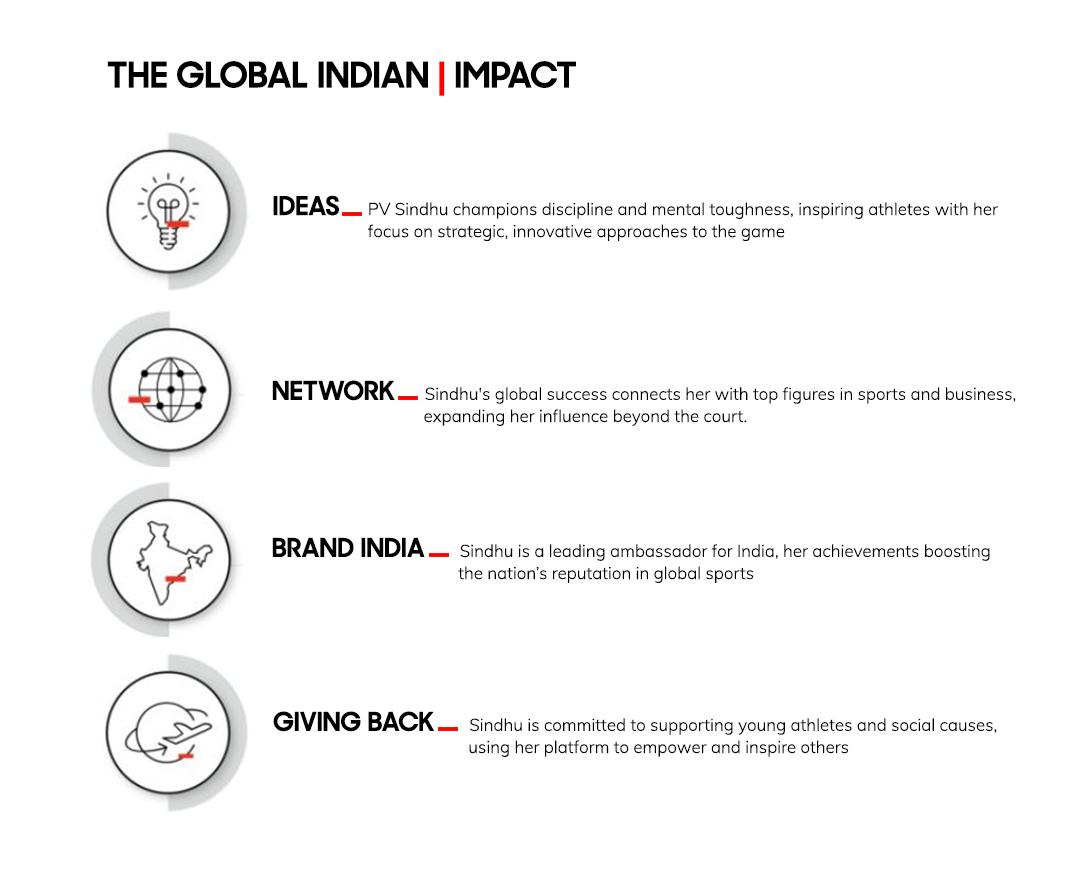
Also Read: Journey of Sania Mirza
FAQs
Who is PV Sindhu’s husband?
PV Sindhu married Venkata Datta Sai on December 22, 2024, in an intimate ceremony in Udaipur attended by family and friends. Datta Sai is an entrepreneur and executive director of Posidex, a data mining company. He holds degrees in Accounting, Finance, and Data Science & Machine Learning. The couple had known each other for years before tying the knot, and Sindhu credits him with bringing stability and happiness to her life, which she felt was essential for her to focus on her professional badminton career and upcoming Olympic cycle.
What is PV Sindhu’s age?
Pusarla Venkata Sindhu was born on July 5, 1995, making her 29 years old as of April 2025. She hails from Hyderabad, India, and has been a prominent figure in Indian badminton since her teenage years. Sindhu’s age places her in the prime of her athletic career, allowing her to combine experience with peak physical fitness as she continues to compete at the highest international levels.
What are PV Sindhu’s achievements in the Olympics?
PV Sindhu is a two-time Olympic medalist. She won a silver medal at the 2016 Rio Olympics, becoming the first Indian badminton player to reach an Olympic final. She followed this with a bronze medal at the 2020 Tokyo Olympics, making her the first Indian woman to win two consecutive Olympic medals in badminton. Sindhu’s Olympic success has significantly raised the profile of badminton in India and inspired a new generation of athletes.
How many medals has PV Sindhu won in her career?
Sindhu has won multiple medals across major tournaments including five medals at the BWF World Championships, a silver medal at the Rio Olympics, a bronze at the Tokyo Olympics, and medals at the Commonwealth and Asian Games. She is the first Indian to become badminton world champion and has also won titles on the BWF World Tour. Her consistent podium finishes have established her as one of the most decorated Indian athletes in badminton history.
What awards has PV Sindhu received?
Sindhu has been honored with prestigious awards such as the Arjuna Award, Khel Ratna Award, Padma Shri, and Padma Bhushan. These awards recognize her outstanding contributions and achievements in Indian sports. Her accolades reflect not only her sporting excellence but also her role as a national icon and inspiration for aspiring athletes across the country.
What is PV Sindhu’s height?
PV Sindhu stands approximately 5 feet 10 inches (178 cm) tall, which gives her a physical advantage on the badminton court with an extended reach and powerful play. Her height helps her cover the court efficiently, execute smashes effectively, and maintain a strong defensive stance, all of which contribute to her competitive edge in international badminton.
What is PV Sindhu’s full name?
Her full name is Pusarla Venkata Sindhu. She is popularly known as PV Sindhu in the sports world. The name “Pusarla” is her family name, and “Venkata” is a common middle name in her region. Sindhu’s full name is often used in formal contexts, while PV Sindhu has become a widely recognized brand in the sporting community.
What is PV Sindhu’s net worth?
As of 2025, PV Sindhu’s net worth is estimated to be around ₹60.7 crore (approximately $7.1 million USD), earned through prize money, endorsements, and other income sources. She consistently ranks among the highest-paid female athletes globally, with brand endorsements from major companies and investments that contribute to her financial success beyond the badminton court.
What is PV Sindhu’s current world ranking?
As of early 2025, PV Sindhu is ranked 17th in the BWF world rankings. She has reached a career-high ranking of No. 2 in April 2017. Sindhu continues to compete at the top level internationally, maintaining her status as one of the elite women’s singles players in the world badminton circuit.
Who is PV Sindhu’s coach?
PV Sindhu is currently training under the Indian women’s singles coach Irwansyah Adi Pratama, who joined the Badminton Association of India in 2025. She transitioned from personal coaching to group training under him at the Prakash Padukone Badminton Academy. Previously, she was coached by Pullela Gopichand, Kim Ji Hyun, Park Tae-Sang, and others, all of whom have played significant roles in shaping her career.
